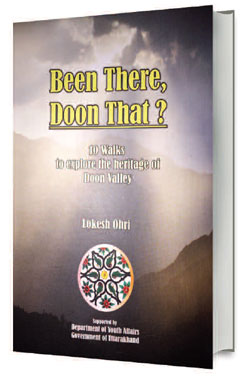 for moST, Dehradun, north of Delhi and the capital of Uttarakhand, is known world-over for its basmati rice, lip-smacking mangoes and litchi. But all that might change soon as Lokesh Ohri’s book Been There, Doon That? points out.
for moST, Dehradun, north of Delhi and the capital of Uttarakhand, is known world-over for its basmati rice, lip-smacking mangoes and litchi. But all that might change soon as Lokesh Ohri’s book Been There, Doon That? points out.
Ohri has taken time off to delve in years of research and hard work to put together this book. The result is a 168-page book that is informative, full of lively anecdotes, a colourful mosaic of historical snippets as well as a walkabout guide for those who love the outdoors.
Put together in an easy flowing format, the book has been divided into 10 chapters, which represent a walk down the long winding roads of Dehradun in one narrative. It begins with an introduction about the heritage of the town that grew after the 1760s, when the spiritual leader Guru Ram Rai first set up camp in the Valley after being divested of his rights to succeed as the spiritual leader of the Sikhs.
The British took such an instant liking to the town that Lord and Lady Dufferin, then at the helm of affairs in the colonial administration, hired a bungalow in the town and spent an entire summer at Nashville Road. Sadly, today the place is a congested, polluted sprawl.
Who would believe that in the 1920s, Dehradun almost became the capital of India and competed with Delhi for the title when Sir Edwin S Montague, the secretary of State for India, was so impressed with its environs and the proximity to Mussoorie that he actively considered shifting the capital to the Valley? These and other forgotten snippets from the past book are an eye-opener.
The writer also states fascinating accounts of urban congested colonies of present-day Khurbura, once a battlefield where the Gurkha and Garhwal forces clashed in a bloody battle, which led to the death of the Garhwal king. Equally incredible is how Hathibarkala in the Cantonment got its name from the majestic intertwining prop roots of the Banyan trees in the ravines that even elephants could pass through.
The book also goes on to emphasise the pleasures of walking the streets and nature trails that the Doon Valley offers in abundance. It gives the more adventurous a brief layout of 10 heritage walks through the length and breadth of Dehradun.
Although the book is a fascinating read, sometime it appears to be an account put together in a hurry. Maps for the 10 heritage walks described through the town could, perhaps, have made the book more interesting as a walk-about guide.
